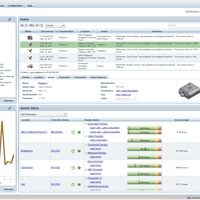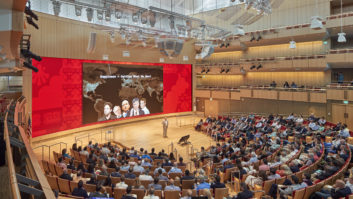
As end user demand for more environmentally friendly products grows, integrators can use their knowledge and knowhow to add significant value to their offerings, writes Ian McMurray. That climate change is happening is largely undisputed: there can, for example, be little argument with the shrinkage of the polar ice caps as a result of the earth warming. Where there is dispute, however, is about the cause of climate change. A vociferous minority claim that it is a natural phenomenon, experienced many times over the earth’s 4,578 billion year history and is a result of changes in solar activity, ocean currents, changes in the earth’s orbit and so on. The majority opinion is that the change is largely man-made, a function of the greenhouse gases emitted by human activity over the past 50 years. According to the UK government, the source of 65% of greenhouse gases is the use of fuel to generate energy, and 21% are as a result of carbon emissions from transport. Perhaps more importantly, it estimates that about 40% of carbon emissions in the UK are the result of decisions taken directly by individuals. The implication is that climate change is something that each of us has the ability to significantly impact. It is undeniable that the AV industry runs on energy – the energy used to create AV products, to install them, to use them and to maintain them. So what is the industry doing to make a contribution – to make itself greener? Inevitably, there is an element of ‘chicken and egg’ in the situation. Should the ‘greening’ of the AV industry be led by end-user demand – or should equipment manufacturers be proactive in developing, and integrators proactive in promoting, greener solutions? Sampling a few end users reveals a somewhat mixed situation. “Green is one of our specification criteria,” says Owen Ellis, who is head of multimedia engineering EMEA at Morgan Stanley, “but it could be higher up the list.” “It’s among our top five criteria,” notes the executive responsible for productivity and collaboration technologies at a global financial institution, “and it’s getting higher in that ranking. Our formal policies are currently under development, but agreed principles are being employed.” “We don’t look at green considerations in any aspect at the moment,” says a senior executive at a $60 billion multinational organisation. Deborah Jones, who is AV/IT sales manager for London’s Queen Elizabeth II Conference Centre, is more positive. “Green is important in our list of AV requirements,” she says, “for both ourselves as a venue and for the majority of our clients.” She cites the centre’s recycling of stage sets, the use of low-voltage LED lighting and recycling of radio microphone batteries each year as examples of its commitment to the environment. “Green isn’t really a major issue for our target customers, if I’m honest,” admits Roland Dreesden, managing director of integrator Reflex. “The intention and desire is there, but I feel it comes to a halt because the availability of products and technologies with green credentials is limited. It can be hard to implement green and to do the right thing.”Solutions is an integrator headquartered in Australia, but with customers in the Middle East. “It’s only been in the past two or three months that our customers have really been asking about this exact topic,” says managing director Mike Bosworth, “and requesting green rating credentials of products that we supply.” Growing demandIt would probably be fair to say that end user demand for green solutions is, at best, patchy – but it’s equally apparent that it’s growing. “Yes, the green issue is becoming an ever increasing consideration,” notes Marc Coleman, sales director at integrator Impact. “Traditional considerations centred around efficiencies such as carbon tonnes saved on travel. More often, it is about the control and optimisation of power consumption. An increasing trend is to look at the green credentials of the manufacturers – in other words, to look at the product provenance in relation to materials used, how they are sourced and the manufacturing process itself.” Both Coleman and Dreesden note the importance of manufacturers – that not only must their products be capable of helping to deliver green solutions, but also those products must be manufactured according to green principles. Certainly, at ISE, there was no shortage of new products touting their increased energy efficiency, with LED-backlit screens being a prime example. OLED technology promises to reduce screen power consumption even further.IMCCA is an organisation that represents the videoconferencing industry. “Green is becoming an increasingly important issue to IMCCA members, both vendor and end-user members,” says Carol Zelkin, its executive director. “IMCCA vendor members help their customers become more green by offering products that support green efforts and demonstrating how, in some cases, minor changes to the way things are done, or which products are selected, can have a major impact to being more environmentally conscious.” She goes on to note that conferencing and collaboration technologies are inherently environmentally friendly, with one financial services firm reporting that its telepresence usage has taken the equivalent of 600 cars off the road each year.Representing the professional audio industry is PAMA. “Sustainability has gone from being an issue to being a standard part of doing business for most PAMA manufacturers,” says Duffy Wilbert, PAMA’s executive director. “This is driven by the customers where sustainability has grown from interest to demand.” “The impact is on two fronts,” he continues. “How we make our products, source our materials, dispose of waste is the manufacturing front – and the other is the retail/selling front, which includes packaging, shipping and collateral support.” Among the actions implemented by PAMA members are looking at how inventory location and its proximity to the end customer can reduce transportation, and moving more product information online instead of printing it. “However,” he points out, “there is still continuing demand for printed materials at the integration companies.” Great responsibilityEven if end user demand is not yet compelling, it becomes apparent that many AV equipment manufacturers are taking their environmental responsibilities increasingly seriously. Taking them equally seriously is InfoComm. “Green is out, sustainability is in, and the AV industry has been unaware of the potential market impact of either one,” says Allen Weidman, sustainability officer at InfoComm International. “Sustainability is good for business but only if business is part of the process – and we, the AV industry, have not had a seat at the sustainability table in the past. We need one for the future of our industry.” InfoComm has devised STEP, a programme that is designed to help all industry participants not only achieve, but measure, more sustainable installations. “STEP is designed to fill a void not addressed by other ‘green building’ rating systems,” continues Weidman. “These existing rating systems have not included audiovisual, communications, information technology, security or building automation systems. The STEP program is intended to engage all stakeholders to accomplish our sustainability goals.” “As important as STEP is to our membership, so is the opportunity to serve as a thought leader and knowledge manager for our members,” he goes on. “That is, providing the information that will help our members compete in the new green marketplace by serving as their eyes and ears in areas of codes, standards, regulations, market trends and product innovations. We will be emailing, blogging and communicating through newsletters and social media as a means to get the information to those that need it.” The programme is, of course, a step in the right direction… If there can be a criticism, it is only that awareness of it outside the US does not seem to be high. “I had never heard of it,” says Ellis, “but now I’ve researched it, I’m amazed that none of the integrators or manufacturers has mentioned it to us before.” “I’ve just been made aware of it,” echoes Bosworth. “Where can I find out more?” Jones is, however, aware of it. “As members of Infocomm International, we are aware of this program,” she says, “but as it is fairly new, we haven’t yet looked at how it could be integrated into our own systems – but we’re watching out for the reaction from both the AV and IT industries.” The next stepWhile CEDIA does not have an equivalent to InfoComm’s STEP programme, that’s not to say that the organisation hasn’t been proactive in promoting green not only to its own members, but also the wider market. “CEDIA member companies are very aware of energy conservation issues and work with a number of other trades to ensure that all subsystems can be fully integrated within, and controlled by, a home’s electronic system,” says Matt Dodd, education chair at CEDIA. “To reflect this trend and generate a higher profile for reducing energy consumption in our homes, we have launched a new category within the CEDIA Awards 2012 scheme entitled Best Integrated Energy Management Solution.” “Also,” continues Dodd, “in 2010, CEDIA introduced its RIBA (Royal Institute of British Architects) training course – ‘Using Technology to Manage Energy in the Home’ – for architects and the building industry. This customised CPD course shows how the custom installation industry can take a proactive approach to implement simple energy-efficiency measures in households across the UK through systems controlling heating, lighting, cooling and power in the home.” Bridging the gapEnd users are starting to want green. Manufacturers are starting to produce green. The link between the two is, of course, the integrator whose job it is to understand the customer’s business goals and be sufficiently knowledgeable to be able to propose appropriate solutions. “There are a number of fairly simple steps that can allow integrators to add significant value in creating greener system in terms of technology and support,” points out Coleman. “Power consumption of every piece of equipment must be considered and combined to provide the least overall power consumption. Control of the system is a crucial component when reducing power consumption. To be able to monitor power and switch off equipment can provide significant savings to a customer in financial terms and a reduction in the environmental impact.” “As an organisation, we use and promote the use of remote monitoring and control,” he continues. “It helps provide quicker response times and reduces the environmental impact of dispatching vehicles to site when it’s not necessary.” “The devil can lie in the detail,” says Dreesden. “There are obvious things you can do – and then there are the less obvious things. Choosing the right screen material, for example, can enable you to propose a less power-hungry projector – and you can encourage the customer to use the projector’s eco mode. Training is vital if the customer is to be able to get the most benefit from the installed system’s ability to use the minimum amount of power – and so is regular maintenance. Where you site equipment can have an important impact on heat dispersion, and thus the amount of energy needed to provide cooling.” Dreesden is especially proud of the numerous actions his company has taken to achieve ISO 14001 accreditation (ISO 14001 provides a framework to assist organisations in developing their own management systems to reduce their impact on the environment). Pairing engineering teams on the basis of where they live allows for greater car sharing, while establishing a central London facility for parts and returns minimises travel to and from the company’s headquarters. Engineers – and others – also have remote access to the company’s systems to minimise the need for travel. Weekend working has been reduced in order to minimise energy consumption – and light switches are labelled so that engineers returning to the office late at night can turn on only the lights they need rather than all of them. Even in Reflex’s company kitchens, its commitment to green practices can be seen in the elimination of disposable cups and plastic spoons, and the regular defrosting of refrigerators. The AV industry is unquestionably moving towards more sustainable, more environmentally friendly installations. End users are starting to attach more importance to it: whether for conscientious or financial reasons is irrelevant. Manufacturers are addressing those concerns with greener manufacturing processes and lower energy products. The industry seems to be in agreement, however, that the key role lies with integrators. It is up to them to understand the broad scope of what it takes to create greener installations – and to promote the benefits of greener AV to the end user community. Ellis sums it up. “Our industry already does a lot when it comes to green,” he says. “I’m not sure it should do more – but could it do more? Definitely.” www.cedia.netwww.imcca.orgwww.impact-europe.comwww.infocomm.orgwww.pama.orgwww.psco.co.ukwww.reflex.co.ukwww.vrs.com.au






